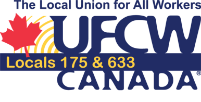Health & Safety

Your Health & Safety Rights
Building a workplace that is healthy and safe for everyone starts with education, empowerment, and action. The Ontario Health & Safety Act requires that employers must provide a safe workplace for workers. But health and safety is everyone’s responsibility. In 2022, the Workplace Safety & Insurance Board (WSIB) received more than 255,000 workplace injury claims. And that’s only the injuries that workers claimed. We know that far more injuries, accidents, and illnesses go unreported every year.
UFCW Locals 175 & 633 is here to:
- Equip Members with the tools and skills they need to recognize and report hazards, and help to create solutions to address those hazards.
- Support Members by ensuring your employer follows the law and abides by your collective agreement.
- Provide resources and assistance to Members, Health & Safety Certified Members, and Joint Health & Safety Committees (JHSCs) to help them achieve improvements in their workplaces and gain a better understanding of the potential hazards they face at work.
Find Health & Safety flyers, posters, and other resources available for download. Don’t see something that you need? Let us know at membership@ufcw175.com.
Visit our Health & Safety FAQ section or check out our glossary of terms to find definitions for words commonly used with Unions, the Labour movement, and your collective agreement.
Federal
Every worker in Canada has three basic rights under Part II of the Canada Labour Code. The Right to Know, the Right to Participate and the Right to Refuse Unsafe Work.
For Provincial regulations, please see below.
Right to Know
- Employees have the right to be informed of known or foreseeable hazards in the workplace and to be provided with the information, instruction, training, and supervision necessary to protect their health and safety.
- This right to know is strengthened by ensuring that methods of communication are appropriate for all employees including employees with special needs.
- Through their health and safety committees or representatives, employees are given the right to have access to government or employer reports relating to the health and safety of employees but do not have access to medical records of any person except with that person`s consent.
The Right to Participate
- As health and safety representatives or committee members, employees have the right and the responsibility to participate in identifying and correcting job-related health and safety concerns.
- Employers who employ 300 or more employees are required to establish a health and safety policy committee.
- The purpose of the policy committee is to handle organization-wide issues. Because these types of issues go beyond a single work place their resolution requires a more strategic or global approach.
- Part II of the Canada Labour Code further provides for employee participation through the use of an internal complaint resolution process.
The Right to Refuse
An employee, at work, has the right to refuse dangerous work if he or she has reasonable cause to believe that:
- A condition exists at work that presents a danger to himself or herself;
- The use or operation of a machine or thing presents a danger to the employee or a co-worker; or
- The performance of an activity constitutes a danger to the employee or to another employee.
Provincial
The Ontario Occupational Health & Safety Act (OHSA) also provides:
Right to Know
Workers have a right to know of every hazard present in their workplace. The employer is to provide workers and their representatives with information to assist them in participating in improving workplace health and safety and preventing injury and death. The right to know was strengthened by the Workplace Hazardous Materials Information System (WHMIS).
Right to Participate
Workers have the right to work with the employer to identify health and safety hazards in their workplace and recommend solutions through the Joint Health and Safety Committee. The Act requires the establishment of Joint Health and Safety Committees in workplaces with 20 or more regular employees, where there is a designated substance or where the Ministry of Labour orders so. Workers and managers are represented equally on Joint Committees. Their power, however, is limited because the Committee cannot implement its recommendations.
The Right to Refuse Unsafe Work
Workers have the right to refuse unsafe work where their health and safety is in danger. For certain workers, such as health care workers and correctional officers, there is a limited right to refuse as doing so may compromise the safety of the workplace. In these circumstances, as a last resort, the Act allows workers to refuse to perform unsafe work. The requirements and procedures that must be followed when workers use this right are as follows:
S. 43(3) A worker may refuse to work or do particular work where he or she has reason to believe that, (a) any equipment, machine, device or thing the worker is to use or operate is likely to endanger himself, herself or another worker; (b) the physical condition of the workplace or the part thereof in which he or she works or is to work is likely to endanger himself or herself; or (c) any equipment, machine, device or thing he or she is to use or operate or the physical condition of the workplace or the part thereof in which he or she works or is to work is in contravention of this Act or the regulations and such contravention is likely to endanger himself, herself or another worker. R.S.O. 1990, c. O.1, s. 43 (3). Once a worker has exercised the “right to refuse” as outlined in the Occupational Health and Safety Act, section 43, the following steps must be followed in order to protect the rights of the worker who is refusing to work. Any alteration in this procedure can nullify the legitimacy of the refusal under the law.
- The worker who has “reason to believe” that their job is unsafe, must immediately tell the supervisor or employer that the work is being refused under the Occupational Health and Safety Act and must explain the circumstances of the refusal.
- The supervisor or employer must investigate the situation immediately, in the presence of the worker, and a worker member of the Joint Committee or a worker health and safety representative.
- Joint Committee or a worker health and safety representative.
- The refusing worker must remain in a safe place near the workstation until the investigation is completed. If the situation is resolved, the worker returns to work. If there is an impasse and the worker has “reasonable grounds to believe” that a danger still exists, he or she can continue to refuse to work. The worker and the employer must ensure that a Ministry of Labour (MOL) inspector is notified. While awaiting the inspector, the worker remains in a safe place, unless other reasonable work is assigned during the normal work hours. The employer can ask another worker to do the refused work, however, the second worker must be told that the work was refused and why in the presence of the worker Joint Committee member. The second worker has the same right to refuse as the first worker.
- The inspector will investigate the refusal in the presence of the employer, the worker and the Joint Committee Member or representative.
- The inspector will make a written decision that must be given to the worker, the employer, and the worker`s representative. A copy of the orders must be posted in the workplace for 14 days. If the inspector finds that no danger exists, the refusing worker must return to work. If the inspector finds that a danger does exist, he or she can issue orders to address the problem. Any party can appeal an inspector`s decision.

